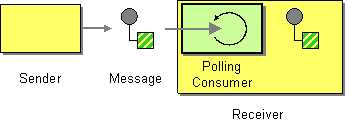
Camel supports implementing the Polling Consumer from the EIP patterns using the PollingConsumer interface which can be created via the Endpoint.createPollingConsumer() method.

So in your Java code you can do
Endpoint endpoint = context.getEndpoint("activemq:my.queue");
PollingConsumer consumer = endpoint.createPollingConsumer();
Exchange exchange = consumer.receive();
|
There are 3 main polling methods on PollingConsumer
Method name |
Description |
|---|---|
Waits until a message is available and then returns it; potentially blocking forever |
|
Attempts to receive a message exchange immediately without waiting and returning null if a message exchange is not available yet |
|
Attempts to receive a message exchange, waiting up to the given timeout and returning null if no message exchange could be received within the time available |
Quite a few inbound Camel endpoints use a scheduled poll pattern to receive messages and push them through the Camel processing routes. That is to say externally from the client the endpoint appears to use an Event Driven Consumer but internally a scheduled poll is used to monitor some kind of state or resource and then fire message exchanges.
Since this a such a common pattern, polling components can extend the ScheduledPollConsumer base class which makes it simpler to implement this pattern.
There is also the Quartz Component which provides scheduled delivery of messages using the Quartz enterprise scheduler.
For more details see